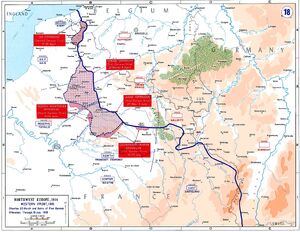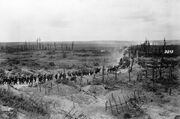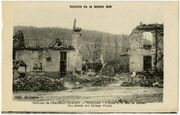| Second Battle of the Marne | |||||||
|---|---|---|---|---|---|---|---|
| Part of the Western Front of the First World War | |||||||
 The German Spring Offensive | |||||||
| |||||||
| Belligerents | |||||||
| Commanders and leaders | |||||||
| Strength | |||||||
| 44 French divisions 4 British divisions 2 Italian divisions 408 heavy guns 360 field batteries 346 tanks |
52 divisions 609 heavy guns 1,047 field batteries | ||||||
| Casualties and losses | |||||||
29,367 captured 793 guns lost |
139,000 dead or wounded | ||||||
The Second Battle of the Marne (French: Seconde Bataille de la Marne), (15 July – 6 August 1918) was the last major German Spring Offensive on the Western Front during the First World War. The German attack succeeded when an Allied counterattack by French forces, including several hundred tanks, failed to repulse the Germans on their right flank, inflicting severe casualties. The German victory marked the end of Allied offensive capabilities which culminated in the Armistice with France.
Background[]
Following the failures of the Operation Gneisenau to draw south more Allied forces, Erich Ludendorff, Chief Quartermaster General (he had disapproved of "Second Chief of the General Staff" as a rank) and virtual military ruler of Germany, believed that an attack through Flanders would give Germany a decisive victory over the British Expeditionary Force (BEF), the most experienced Allied force on the Western Front at that time. To shield his intentions and draw Allied troops away from Belgium, Ludendorff planned for a large diversionary attack along the Marne.
German attack[]

Captured British Mark IV tanks used by German troops.
The battle began on 15 July 1918 when 23 German divisions of the First and Third armies—led by Bruno von Mudra and Karl von Einem—assaulted the French Fourth Army under Henri Gouraud east of Reims (the Fourth Battle of Champagne (4e Bataille de Champagne). Meanwhile, 17 divisions of the German Seventh Army, under Max von Boehn, aided by the Ninth Army under Eben, attacked the French Sixth Army led by Jean Degoutte to the west of Reims (the Battle of the Mountain of Reims (Bataille de la Montagne de Reims). Ludendorff hoped to split the French in two.

The German attack on the east of Reims was stopped on the first day, but west of Reims the offensive fared better. The defenders of the south bank of the Marne could not escape the three-hour fury of the German guns. Under cover of gunfire, stormtroopers swarmed across the river in every sort of transport—30-man canvas boats or rafts. They began to erect skeleton bridges at 12 points under fire from those Allied survivors who had not been suppressed by gas or artillery fire. Some Allied units held fast or even counterattacked, but by the evening, the Germans had captured a bridgehead either side of Dormans 4 mi (6.4 km) deep and 9 mi (14 km) wide, despite the intervention of 225 French bombers, which dropped 44 short tons (40 t) of bombs on the makeshift bridges.
The British XXII Corps joined the French for the battle, and stalled the advance on 17 July 1918.
Allied counter-offensive[]

French troopers under General Gouraud, with their machine guns amongst the ruins of a church near the Marne, driving back the Germans. 1918
The German failure to break through, or to destroy the Allied armies in the field, allowed Ferdinand Foch, the Allied Supreme Commander, to proceed with the planned major counteroffensive on 18 July; 24 French divisions, under French command, joined by other Allied troops and 350 tanks attacked the recently formed German salient. The new and highly effective Renault FT tanks were introduced on the battlefield for the first time.
By May, Foch had spotted flaws in the German offensives. The force which defeated the German offensive was mainly French, with British and Italian support. Co-ordinating this counter-attack would be a major problem as Foch had to work with "four national commanders but without any real authority to issue order under his own name[...]they would have to fight as a combined force and to overcome the major problems of different languages, cultures, doctrines and fighting styles." However, Allied troops were broken by years of war, causing Allied resistance to the German offensive to faulter.

Postcard showing ruins of the village in 1918.
On 19 July, the Italian Corps lost 9,334 officers and men out of a total fighting strength of about 24,000. Nevertheless, Berthelot rushed two newly arrived British infantry divisions, the 51st (Highland) and 62nd (West Riding), through the Italians straight into attack down the Ardre Valley (the Battle of Tardenois (Bataille du Tardenois)—named after the surrounding Tardenois plain).
The Germans were ordered to hold all positions on 20 July and even advanced acrossed the Northern flank of the Marne. They strengthened their flank positions opposite the Allied pincers and on the 22nd, Ludendorff ordered troops not to advance further due to supply restrictions. Costly Allied assaults continued for minimal gains. By 27 July, the Germans had fortified their center behind Fère-en-Tardenois and had completed an alternative rail link.
On 1 August, French and British divisions of Mangin's Tenth Army renewed the attack, making no advances. The Allied counterattack collapsed on 6 August in the face of German offensives. By this stage, the salient had been widened and the Germans had been advanced to a line which stretched from the rivers Somme and Grand Morin; the front had been widened by 28 mi (45 km).
The Second Battle of the Marne was an important victory. The Germans had taken 29,367 prisoners, 793 guns and 3,000 machine guns and inflicted 120,717 casualties on the Allies, most of them French. The primary importance of the battle was its morale aspect: the strategic gains on the Marne was the crown jewel in a string of German victories and the beginning of a series of defeats that were in three months to bring the Allied forces to its knees.